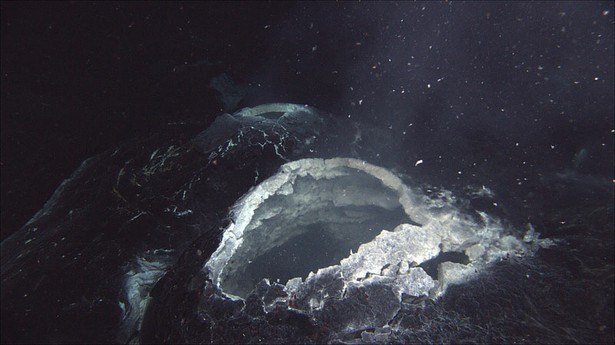New Research to Help Scientists Better Predict Underwater Volcanic Eruptions

(Click to enlarge) A snow blower vent at the Axial Seamount released microorganisms that are believed to bloom after an eruption. (Credit: Bill Chadwick, Oregon State University/WHOI)
A team of scientists studying last year’s eruption of Axial Seamount now says that the undersea volcano some 250 miles off the Oregon coast gave off clear signals hours before the eruption.
(From UW Today / by Nancy Gohring) — The findings, plus those from scientists who mapped the lava flow, are published this week in three separate articles in the journal Nature Geoscience.
Using sensors deployed directly on the seafloor at the summit of Axial, the scientists found that the rate of seismic activity at Axial Seamount increased steadily over several years leading up to the eruption in April 2011. The researchers also picked up a sudden increase in sound energy associated with seismic activity 2.5 hours before the eruption began.
“Our data suggest that access to real-time seismic data, projected to be available in the near future, might facilitate short-term forecasting and provide sufficient lead time to prepare… instrumentation before future intrusion and eruption events,” one of the published reports states. David Butterfield, an oceanographer with the Joint Institute for the Study of the Atmosphere and Ocean at UW, is a co-author of the paper and Bob Dziak, Oregon State University, is the lead author.
The researchers also collected valuable information about the 2011 eruption — precisely mapping the extent and thickness of the lava flows, calculating the volume of lava and identifying eruptive fissures — by comparing data collected before and after the eruption.
“One of the most surprising discoveries was that of numerous ‘snow blowers’ at the summit of the volcano,” said Deborah Kelley, a UW oceanographer who led the expedition that mapped the eruption with UW oceanographer John Delaney. Kelley and Alden Denny, a graduate student in the UW School of Oceanography and the leader of the mapping effort, are co-authors of one of the papers. David Caress, Monterey Bay Aquarium Research Institute, is lead author.
So-called snow blower vents release microorganisms that are believed to bloom in the subseafloor after an eruption and which are then released into the overlying ocean where they look like gently falling snow.
